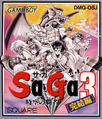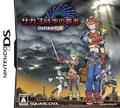Welcome to the SaGa Wiki! We have moved off Fandom very recently, so things are still being set up around here. Please note that some images did not successfully transfer, and will need to be manually reuploaded or replaced.
Note: Keep in mind that once you have an account, you must wait one day and make 5 edits to become autoconfirmed. This allows you to skip questions while editing, to create new articles, and to upload images.
SaGa 3: Jikuu no Hasha
Final Fantasy Legend III (Jikū no Hasha ~ Sa・Ga 3 [Kanketsu Hen] (時空の覇者 Sa・Ga3 [完結編]) is the third game in the SaGa series. Initially released for the GameBoy in Japan in December 1991, the game was made available in North America nearly two years later in September 1993.
In September 2010, Japanese magazine Famitsu announced that a remake of Final Fantasy Legend III for the Nintendo DS was being developed and would feature fully three-dimensional cel-shaded graphics. It was released on January 6, 2011, so far exclusively in Japan.
Plot
Final Fantasy Legend III combines fantasy and sci-fi elements. Four characters, Arthur, Curtis, Gloria and Sharon, are sent back in time to prevent a massive global flood from destroying the world. To accomplish their mission, the heroes, along with companions aiding them on their journey, must travel through time by augmenting their flying time ship, the Talon, with 13 upgrade units from the past and future.
Characters
- Arthur
- Curtis
- Gloria
- Sharon
- Myron
- Dion
- Faye
- Lara
- Borgin
Development
SaGa 3 was developed by the newly established Osaka branch of Square, who would go on to produce Final Fantasy Mystic Quest for the SNES. The game was produced by Chihiro Fuijoka, and stands as the only mainline entry in the series not produced by series creator Akitoshi Kawazu. This largely explains why the game lacked many of the unique features of the earlier entries, and utilized a more conventional leveling system. Despite this, the new studio was said by the producer to have poured a lot of effort into the title in order to prove themselves to the company.
The game was also the first translation project by Ted Woosely who would go on to translate many of Square's most iconic games for the SNES.
When the game was remade for the DS, in addition to the new graphics, the gameplay was altered to make it more inline with the original SaGa games, by removing the convention EXP. system with the earlier entrie's mechanics.












